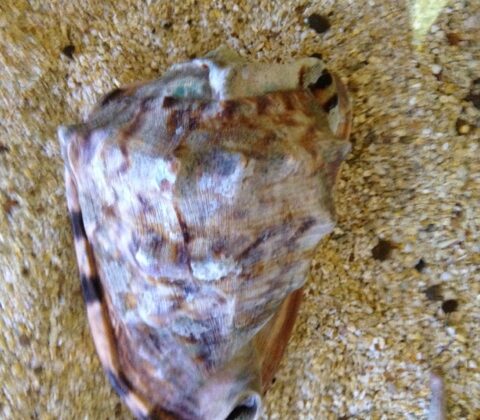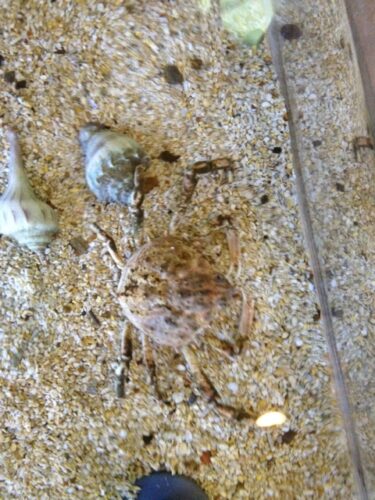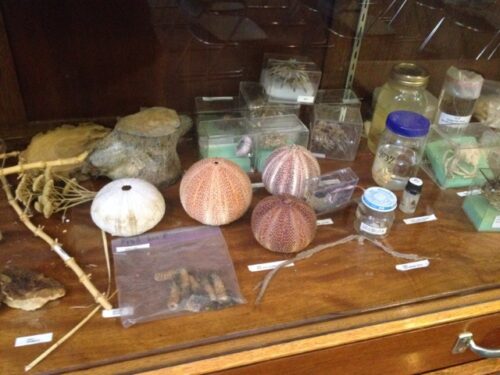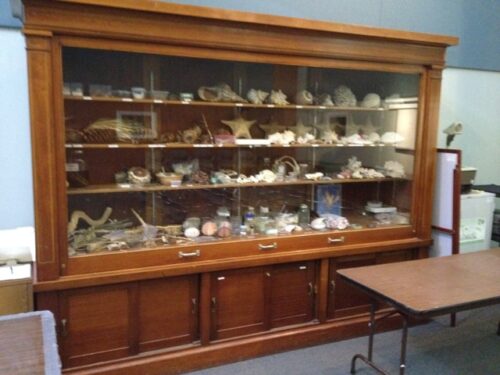
I worked my first training session on running the invertebrate touchpool at the Albuquerque Aquarium. It is a completely different experience than volunteering at the Shark and Ray Encounter. Both the volunteers and the aquarium guests get to spend much more time interacting with the animals.
I worked this shift with an experienced invertebrate touchpool volunteer named Kenny and Chelsea who is another volunteer in training like myself. Kenny is heading to Florida this fall to study marine biology and he was very knowledgeable about the animals in our care. I learned a lot from him and I have included most of what I learned below.
As a volunteer with the invertebrate tank, you have to lift the animals up to show to the guests and to allow them to contact the shells or exoskeletons. In the photo above, Kenny is showing some young guests the horseshoe crab. Here is the list of the animals we had in the tank and some of the facts about them that we share with aquarium visitors.
Mollusks
From the Mollusk family we had the whelk and helmet conch. Most of the guests didn’t even realize they were live animals until we flipped them over.
The common things we would point out to the guests are the features of the animal such as their shell and operculum. Their shells are made of calcium carbonate and both animals produce the shell they live in. It is part of their body and they cannot live without it. The whelk and helmet conch also both have a trapdoor piece called an operculum that they use to seal themselves off inside of their shells for protection. Both animals were shy and spent the entire time sealed away inside their shells.
Crabs
We had two types of crabs on display; the hermit crab and the spider crab.
Most guests knew immediately what the hermit crab was named. We would pick up the crab and allow guests to contact their shells. One hermit crab lived up to his crab part of his name and gave me quite a pinch. He was not in the mood to be handled.
The spider crab is a little trickier to handle. She also gave me a good pinch a couple of times. Kenny showed me how to pick her up so that the guests could contact the top of her shell and she couldn’t grab me.
Horseshoe Crab
You may think that this creature belongs on the previous group, but the horseshoe crab isn’t a crab at all. It is actually more closely related to scorpions and spiders. The horseshoe crab was definitely one of the favorites with the guests. He was constantly moving around the tank.
We showed guests that the crab has multiple sets of eyes. One set that are compound eyes that see images similar to how we see and a second set of simple eyes that only detect light.
Sea Urchin
The sea urchin we had on display is a pencil sea urchin. It moved slowly so some of the guests didn’t even realize it was alive. On the urchin, we would allow guests to contact some of its spines and flip it over to point out the mouth part. Sea urchins eat kelp and sea weed so they have three sharp teeth which allow them to cut through tough plants. I forgot go get a picture of the urchin, but I did get a picture of the urchin shells we had in the teaching tools cabinet:
Anemone
The Anemone is the only creature we had in the tank that guests were not allowed to touch. They were only allowed to look at it. We instructed guests that it was a relative of jelly fish and described how it served as a host to another famously known sea creature, the clown fish. Most of the younger guests immediately knew we were talking about Nemo.
Some of the guests really struggled with saying the word anemone. It tongue tied me a few times as well.
The Teaching Tools
In one of my previous posts (“You’re Mean!” and The Problem With Shark Fin Soup) I mentioned that we have various teaching tools that we use to help teach the guests about the animals they see in the aquarium. Here is a shot of the cabinet where those teaching aids are kept.
We have quite a collection to choose from and I love that the Albuquerque Aquarium has made this available for the volunteers to use at the touchpools. There’s nothing greater than seeing the eyes light up on both young and old people alike when they see something for the first time. So far I have only use the stingray stingers and the shark fin, but I will probably pull out some of the invertebrate teaching aids for my next shift.
One more to go
I only have one more training session to go before I become a certified volunteer at the aquarium. My certification test is scheduled for this coming Saturday. Wish me luck!
If you love your local public aquarium, tell me about it in the comments section below. What is your favorite invertebrate animal?
















Damn, I wish there was an aquarium in Mexico City. )=